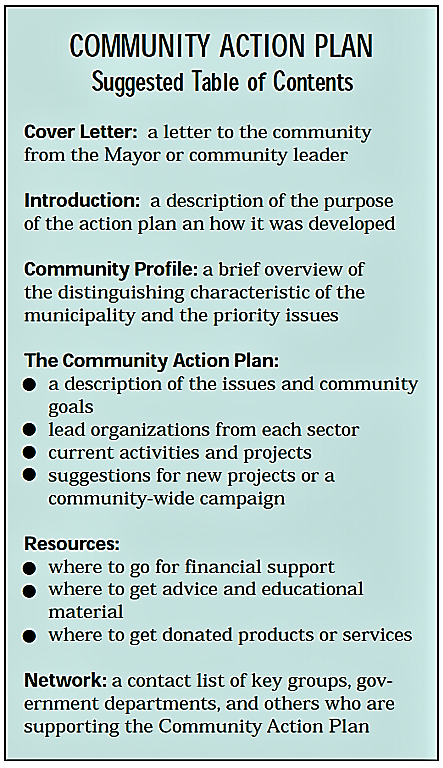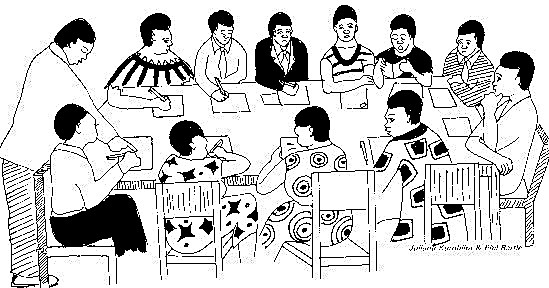Resumen ejecutivo
A community action plan is a road map for implementing community change by identifying and specifying WHAT will be done, Who will do it and HOW it will be done. In other words, the action plan describes what the community wants to accomplish, what activities are required during a specified timeline and what resources (money, people and materials) are needed to be successful. The community action plan shall become a framework for implementing sustainable sanitation and water management activities that are decided by the community itself. It is important to emphasise that the community members should be the main actors in preparing their own community action plan regarding sanitation and water management.
What Is a Community Action Plan?
(Adapted from ACPHD 2004; FAO 2001; UNDP n.y.)
“A healthy community is a form of living democracy: people working together to address what matters to them”.
The community action plan is one of the participatory tools used to build the capacity of community members in taking action in accordance with the problems, needs, and potential of the community (see also problem analysis and decision making, both categories on Decision Making section).
The community action plan is a road map for implementing community change in sanitation and water management by clarifying what will be done, who will do it and how it will be done. The plan describes what the community wants to achieve, what activities are required during a specified time period, what resources (money, people and materials) are needed to be successful.
The community action plan should become a framework for implementing the activities that are decided by the community itself. The focus is more on the process of understanding and overcoming problems in order to rebuild the people's lives rather than just physical development such as building houses, providing clean water or toilet facilities. It is important to understand that the community should be the main actors in preparing their own community action plan. Producing the action plan helps people to take realistic and concrete steps toward participatory development planning in order to improve the sanitation and water system. By bringing everyone together to think and discuss about resources and group involvement, this tool increases awareness (see PPT) about the skills and resources already available in the community.
Key Elements of a Community Action Plan for Sanitation and Water Management
(Adapted from MIT n.y.)
The key element of community action planning is an active, intense community-based workshop, carried out over a time period of 2 to 5 days, depending on the specific objectives of the workshop (see also exploring tools). The output of the workshop is a sanitation and water management development plan which contains a list of prioritised problems, strategies and options for dealing with the identified problems. A rudimentary work programme describes who, when and what is to be done. Integral to the method is the equal relation between the professional technical inputs and planned over specified intervals – once each year tends to be appropriate – with the implementation of agreements during the interval.
The execution of the workshop requires a minimum of preparation, materials and training. Of prime importance is a motivated community and a confident moderator/facilitator/organiser who can take the lead in assuring that announcements are made, participants identified, a location selected, a few materials collected, and finally in running the workshop. However, most of the preparation should be done by the community itself. A designated person often takes responsibility for the logistics. Moderators need not be highly skilled and can adapt the style and content to suit their own temperament and the prevailing circumstances. Training of moderators/facilitators can be minimal, but is strongly advised to participate in an actual workshop in order that future moderators can capture the dynamics of the event as much as understand its procedures (see also train the trainers perspective).
Materials required are limited to markers of some kind, large sheets of paper (any kind: wrapping paper, newsprint, cardboard, unfolded boxes), and a place for display of outputs.
The location for the workshop should be in the community and easily accessible, rather than in government offices. Example locations have included formal classrooms.
General Principles of Community Action Plans
(Adapted from UNDP n.y.)
- It is a process for action; not a blueprint for future development.
- The solution for problems comes from the community itself and the role of the facilitator is more on formulating the problems in the community.
- It is not determined from outside the community but grows/emerges from the affected community.
- Avoid activities such as lecturing or teaching the people; but concentrate more on workshops as a form of discussion with the community.
- Guarantee that all relevant groups participate in the activities, particularly the women and other community groups that are often forgotten.
- Facilitate input from all groups; do not allow one group or leader to dominate the discussion.
- Remember that one issue might appear to be not very important for one group, but is important for another group.
- Avoid too many pictures and text; it is better to absorb and remember several points rather than make a long list.
- Use simple language and avoid difficult terms.
- Make the material as simple as possible.
Steps in Formulating a Community Action Plan

(Adapted from UNDP n.y.)
The development and formulation of a community action plan consists of several standard measures that are generally applicable. However, in practice, the specific context and nature of community needs in sustainable sanitation and water management will add uniqueness to those measures.
The stages in formulating a community action plan can be described as the following:
-
Opening: Introduction and Socialisation: This first stage intends to provide a common understanding of the importance of having a good action plan, and a common understanding of why an action plan is needed.
-
Social and Environmental Mapping financing: This stage is meant to gain an understanding of the latest conditions in the community life that is the social, economic, as well as environmental conditions. By developing a map, the community will be able to get a better picture of problems and priorities (see also understand your system).
-
Identifying the Problems, Needs, and Resource Potential: This stage defines the problems that are actually faced by the community, the needs that must be fulfilled in order to overcome the (sanitation and water management) problems, and the financial resources (see PPT) available to accomplish the needs. This process of identification should be done carefully in order to avoid becoming just a task of making a “wish list”, and should be viewed as a process of understanding the current situation and what must be done to overcome the situation as fast as possible.
-
Determining the Priority in Problems and Needs: In this stage the problems and needs are ranked by the community members according to their level of urgency (see preference ranking), their importance for the development of community life, and the opportunity to overcome and to fulfil (viewed in terms of the availability of local resources as well as external resources that might be reached).
-
Formulating the Choice of Strategy: In this stage, the strategy is developed and the approach chosen that is the most feasible to be used in overcoming the problems and fulfilling the needs on the priority list (see also deciding).
-
Formulating the Choice of Action: In this stage, it is determined which action has to be taken in implementing the chosen strategy and approach.
-
Formulating the Implementation Plan: This stage is used to formulate a schedule and the division of tasks in carrying out the action chosen (see also stakeholder strategy plan).
-
Formulating the Monitoring and Evaluation Plan: This stage is used to formulate a plan and system of monitoring and evaluating the execution of activities.
-
Implementation, Monitoring and Evaluation: This final stage consists of carrying out the action, and at the same time monitoring and evaluating. For more information on these individual steps, see also implementation).
Considerations for Completing a Community Action Plan

(Adapted from ACPHD 2004)
The following points should be taken into consideration in completing a community action plan:
-
Partnerships among people. In order to accomplish the goals and objectives in the plan how to improve the sanitation and water system of your area, many people will have to be integrated and have to fully participate in doing the work. It is important that the involved people develop good relations and trust among each other (see also stakeholder analysis starting by stakeholder identification factsheet).
-
Budget. Financial resources are usually necessary to develop and carry out a community action plan for sanitation and water management. Therefore, it is important to develop a budget that describes the expenses for carrying out the action plan. What you include in the budget should match the proposed strategies and activities (see financing and sources of funding).
-
Close alignment with the community’s mission and vision. The vision that was developed during the community assessment process reflects where the community wants to be headed. The mission is the purpose of your group. During the writing of the action plan, the writers work from the vision and the mission to identify several major goals (priority or strategic) that must be reached. These, in total, work toward the vision and the mission.
-
A feasible plan does not have to be “perfect”. More important than a “perfect” action plan for sanitation and water management is one that is feasible for the community partnership to complete within a reasonable period of time. The action plan is a working document that can be reviewed as the group implements it. It is a starting point that people can continue to update and revise as community groups learn over time and through their evaluation, how to accomplish their goals.
When local community members are keen to change and improve their sanitation and water system respectively management, they first need a community action plan which describes what the community wants to achieve, what activities are required and what resources are needed to be successful.
A community action plan is required and should be applied whenever community members want to be the engine of the change regarding sanitation and water issues. It is of prime importance to strongly integrate local people in the planning of their water and sanitation system in order to achieve a sustainable solution which is highly accepted and supported by the local community.
A Handbook for Participatory Community Assessments Experiences from Alameda County
This handbook describes various tools for participatory community assessments. Step 8 explains how to write a community action plan.
ACPHD (2004): A Handbook for Participatory Community Assessments Experiences from Alameda County. Oakland: ACPHD URL [Visita: 07.07.2019]Field Level Handbook. SEAGA Socio-Economic and Gender Analysis Programme
This SEAGA Field Handbook is written for development agents who work directly with local communities in developing countries. It is intended for outsiders such as extensionists, government and non-government field workers, and private- and public-sector development consultants, and for insiders such as community organisers and leaders of local groups and institutions. The purpose of this handbook is to support participatory development planning at the community level.
FAO (2001): Field Level Handbook. SEAGA Socio-Economic and Gender Analysis Programme. Rome (Italy): FAO URL [Visita: 07.07.2019]Interactive Community Planning: Community Action Planning (Micro Planning)
Community Action for the Environment. A Guide to Helping Your Community Go Green
The Conservation Council of Ontario has published a guide to community organising, including setting up a coordinating committee, a community network, an action plan, and ideas for community campaigns and projects. The guide draws on their experience working with both big and small communities. It is a low-cost approach to organising local businesses, agencies, and governments for action on your community's issues!
TCCO (1995): Community Action for the Environment. A Guide to Helping Your Community Go Green. Ontario: The Conservation Council of Ontario. [Accessed: 22.04.2012] PDFAche-Nias Settlement Support Program. ANSSP Guidelines
This document is an example of a community action plan in Ache. The document gives a good introduction to the community action plan and explains it principles and how to apply.
UNDEP (n.y): Ache-Nias Settlement Support Program. ANSSP Guidelines. CAP community action plan and Village Mapping. [Accessed: 11.08.2010] PDFPreparing a Community Action Plan
A Handbook for Participatory Community Assessments Experiences from Alameda County
This handbook describes various tools for participatory community assessments. Step 8 explains how to write a community action plan.
ACPHD (2004): A Handbook for Participatory Community Assessments Experiences from Alameda County. Oakland: ACPHD URL [Visita: 07.07.2019]Field Level Handbook. SEAGA Socio-Economic and Gender Analysis Programme
This SEAGA Field Handbook is written for development agents who work directly with local communities in developing countries. It is intended for outsiders such as extensionists, government and non-government field workers, and private- and public-sector development consultants, and for insiders such as community organisers and leaders of local groups and institutions. The purpose of this handbook is to support participatory development planning at the community level.
FAO (2001): Field Level Handbook. SEAGA Socio-Economic and Gender Analysis Programme. Rome (Italy): FAO URL [Visita: 07.07.2019]Community Action for the Environment. A Guide to Helping Your Community Go Green
The Conservation Council of Ontario has published a guide to community organising, including setting up a coordinating committee, a community network, an action plan, and ideas for community campaigns and projects. The guide draws on their experience working with both big and small communities. It is a low-cost approach to organising local businesses, agencies, and governments for action on your community's issues!
TCCO (1995): Community Action for the Environment. A Guide to Helping Your Community Go Green. Ontario: The Conservation Council of Ontario. [Accessed: 22.04.2012] PDFAche-Nias Settlement Support Program. ANSSP Guidelines
This document is an example of a community action plan in Ache. The document gives a good introduction to the community action plan and explains it principles and how to apply.
UNDEP (n.y): Ache-Nias Settlement Support Program. ANSSP Guidelines. CAP community action plan and Village Mapping. [Accessed: 11.08.2010] PDFGetting communities engaged in water and sanitation projects: participatory design and consumer feedback
Community engagement in water and sanitation service delivery is key for ensuring project sustainability and accountability. This Topic Brief looks at community engagement approaches used by WSUP in three cities within the African Cities for the Future (ACF) programme: Antananarivo (Madagascar), Kumasi (Ghana) and Maputo (Mozambique). The Topic Brief highlights some of the key challenges, and ends with practical recommendations for programme managers about how to engage low-income communities in the design of water supply and sanitation projects.
WSUP (2013): Getting communities engaged in water and sanitation projects: participatory design and consumer feedback. London: Water & Sanitation for the Urban Poor (WSUP) URL [Visita: 30.06.2019]Community-Driven Sanitation Improvement in Deprived Urban Neighbourhoods
There is an international consensus that urban sanitary conditions are in great need of improvement, but sharp disagreement over how this improvement should be pursued. Both market-driven and state-led efforts to improve sanitation in deprived communities tend to be severely compromised, as there is a lack of effective market demand (due to collective action problems) and severe barriers to the centralized provision of low-cost sanitation facilities. In principle, community-driven initiatives have a number of advantages. This report investigates these challenges and opportunities.
MCGRANAHAN, G. (2013): Community-Driven Sanitation Improvement in Deprived Urban Neighbourhoods. Research Report. London, Bangladesh: London School of Hygiene and Tropical Medicine (LSHTM), International Center for Diarrhoeal Disease Research (ICDDR), International Institute for Environment and Development (IIED), WaterAid, Sanitation and Hygiene Applied Research for Equity (SHARE) URL [Visita: 17.06.2019]Communities That Care Coalition. Community Action Plan
The Communities That Care (CTC) coalition started in 2002 as a group of community members interested in addressing alcohol, tobacco and other drug use among youth. The CTC coalition’s community action plan outlines the programs, policies and practices to be implemented and specifies measurable desired outcomes in terms of teen behaviour as well as process measures of the coalitions’ progress toward meeting these goals. Though not from the water and sanitation context, this is still a valuable study to understand community action plans in practice.
CTC Collation (2005): Communities That Care Coalition. Community Action Plan. Massachusetts: CTC Collation URL [Visita: 07.07.2019]Tools for Community Participation. A Manual for Training Trainers in Participatory Techniques
This manual focuses on one approach to participatory training which PROWESS has applied in numerous projects and workshops. Intended primarily for the training of trainers in participatory techniques, it describes these techniques in a "how to" step-by-step fashion. This manual is also intended to be a "discussion starter" and delves into some of the political issues underlying participation and the often conflicting priorities of communities and development practitioners.
SRINIVASAN, L. (1990): Tools for Community Participation. A Manual for Training Trainers in Participatory Techniques. New York: PROWESS/UNDP Technical Series
